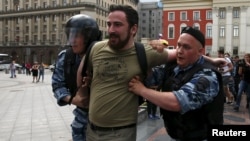Sculptures by a renowned Soviet artist on show in central Moscow were smashed after being denounced by Orthodox activists as "blasphemous."
"Delusional people came to the exhibition who broke several works belonging to the Manege collection, by Vadim Sidur," said Yelena Karneyeva, a spokeswoman for the Manege art center, by the Kremlin walls.
"Several sculptures are completely smashed," she said on August 14, adding that police had come and led away the activists. The works were made of plaster and linoleum.
A police spokesman said he could "confirm the incident happened and that currently all the participants of the conflict have been taken to the station to write statements."
A well-known Orthodox activist, Dmitry Tsorionov, known by the nickname Dmitry Enteo, earlier said he was at the Manege exhibition center.
"We called the police," he said. "They will close the exhibition for offending believers."
Enteo, quoted by the Interfax news agency, had said the exhibition included an "indecent" depiction of Jesus Christ and was a "dirty, harsh mockery of Jesus Christ and the saints."
The head of the nationalist God's Will group is a prominent conservative activist. He cites Orthodox values while picketing and heckling at arts events and protests, sometimes with a television camera crew in tow. This year he attempted to stop a gay-pride rally in Moscow.
The exhibition -- called Sculptures That We Don't See -- showed works by Soviet sculptors that did not see the light of day during the Soviet period because they were nonconformist.
The show, which opened to the public on August 14, included some works with religious themes, including a crucifixion bas-relief.
Sidur was an avant-garde artist unable to show his nonconformist works publicly in the Soviet era. He died in 1986. A museum in Moscow is now dedicated to his work, and his art has been sold at international auction houses such as Sotheby's.
The attack on his works prompted swift condemnation.
"Now Orthodox warriors are smashing a sculpture exhibition in the center of Moscow. Hail the Russian [Islamic State]," Vladimir Varfomoleyev, a journalist at the popular Echo of Moscow radio station, wrote in a tweet.
Artist Alexei Knedlyakovsky, whose installation about the Russian protest movement was damaged by Enteo last year, wrote in a tweet: "Maybe after this Enteo will finally get jailed?"
An Orthodox Church spokesman, Vladimir Legoida, told RIA Novosti news agency there must be a "legal assessment" of the attack, while stressing that believers "undoubtedly have the right to protest."
Vakhtang Kipshidze, a spokesman for the Russian Church Synod, said protesters should act civilized and avoid doing anything illegal, though he stressed they have a right to protest against art that insults religion,
"Violence is always spearheaded at people in one way or another, and it cannot be justified by the defense of interests of any social group," he said.
In recent years, religious fundamentalist activists have targeted a number of exhibitions in Moscow and forced them to shut down, while organizers have been fined for inciting hatred.
In 2007, activists attacked an exhibition at Moscow's Sakharov Center called Warning, Religion!, complaining it insulted believers.
The exhibition included a print of Jesus with the head of Mickey Mouse and a spoof ad for Coca-Cola with the slogan, "This is my blood."
Russia in 2010 convicted the organizers of inciting religious hatred and fined them.
The Sakharov Center's director was fined in 2005 for inciting religious hatred with another exhibition called Warning, Religion!
Activists poured red paint on the walls and paintings, and smashed windows at the 2003 exhibition.
Such attacks on exhibitions carry echoes of brutal Soviet-era treatment of contemporary artists seen at the time as being ideologically unsound.
The Manege exhibition center was the scene of one of the most famous Soviet-era crackdowns on contemporary art.
In 1962, then-Soviet leader Nikita Khrushchev visited an exhibition of abstract painting at the gallery and angrily denounced the artists as "fags" and "bastards."
In 1974, the authorities sent in a bulldozer to destroy an improvised exhibition in a park in southwestern Moscow by avant-garde artists.









